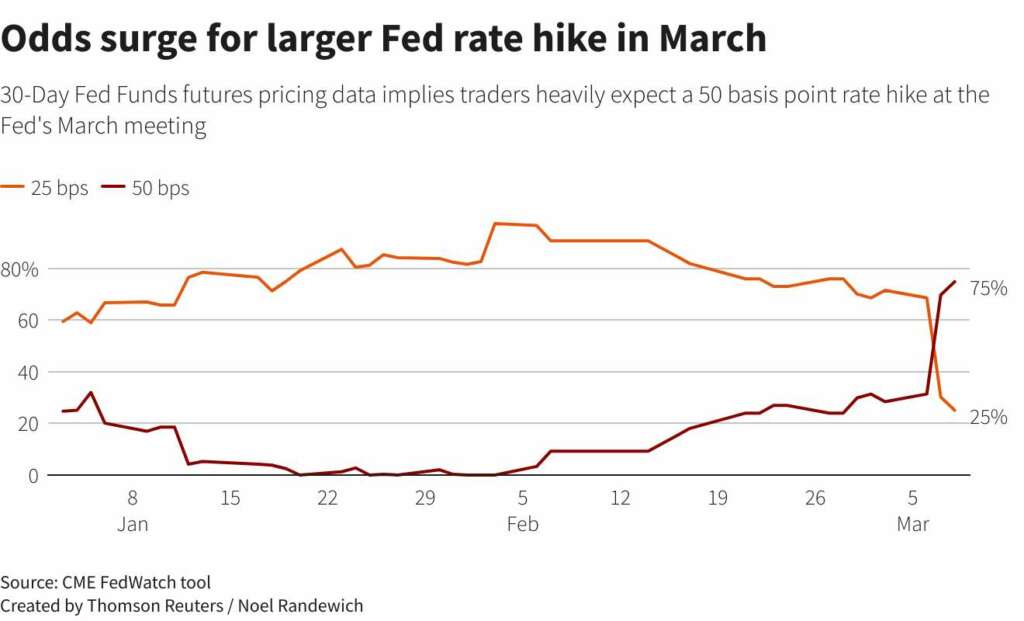
By Stephen Culp
NEW YORK (Reuters) – U.S. stocks struggled for direction and Treasury yields wavered on Wednesday as a barrage of robust economic data appeared to support Federal Reserve Chairman Jerome Powell’s reassertion, in his second day of congressional testimony, that the central bank would continue to ratchet up policy rates until inflation subsides.
The major U.S. stock indexes oscillated between modest gains and losses in a subdued session, and the dollar paused its advance the day after a broad sell-off in the equities market driven by Powell’s first day before a Congressional banking committee.
In his second day on Capitol Hill, Powell repeated his hawkish message that key interest rates would likely be raisedpotentially faster than previously anticipated, but stressed the central bank’s policy decisions remain data dependent.
“Yesterday the Fed opened the door to more interest rate increases and did not close it today,” said David Carter, managing director at JPMorgan Private Bank in New York. “There’s lots of uncertainty as to when the rate increase journey will end; even in a marathon you know it’s over in 26.2 miles, but nobody knows where this finish line is, or if there is one more long hill.”
Data released on Wednesday painted a picture of U.S. economic hardiness, and did very little to assuage those fears.
Job openings remain elevated, private payrolls beat consenusconsensuses, and demand for home loans increased, despite the ongoing upward trajectory of mortgage rates.
“If future increases are based on the economic data, the economic data continues to paint an unclear picture, which suggests the path of future rate increases is also unclear,” Carter added.
Robust economic data could embolden the central bank to keep the Fed funds target rate higher for longer.
Financial markets have priced in an 80.8% likelihood of a 50 basis point hike to the key interest rate at the conclusion of the Fed’s March meeting, up from about 30% at the beginning of the week, according to CME’s FedWatch tool.
GRAPHIC: Odds surge for larger Fed rate hike in March – https://www.reuters.com/graphics/USA-RATES/FEDWATCH/lbpgglxbrpq/chart.png

The Dow Jones Industrial Average fell 137.28 points, or 0.42%, to 32,719.18, the S&P 500 lost 4.62 points, or 0.12%, to 3,981.75 and the Nasdaq Composite added 14.56 points, or 0.13%, to 11,544.89.
European stocks closed nominally higher as market participants weighed the strong U.S. data and downward revisions to fourth quarter euro zone economic growth.
The pan-European STOXX 600 index rose 0.08% and MSCI’s gauge of stocks across the globe shed 0.29%.
Emerging market stocks lost 1.06%. MSCI’s broadest index of Asia-Pacific shares outside Japan closed 1.42% lower, while Japan’s Nikkei rose 0.48%.
Benchmark Treasury yields wavered, and two-year yields moved close to a 16-year high.
Benchmark 10-year notes last fell 1/32 in price to yield 3.9795%, from 3.975% late on Tuesday.
The 30-year bond last rose 3/32 in price to yield 3.8822%, from 3.888% late on Tuesday.
The greenback was wavered close to the flatline against a basket of world currencies after touching a three-month high in Tuesday’s session after investors digested Powell’s hawkish testimony.
The dollar index rose 0.08%, with the euro up 0.01% to $1.0548.
The Japanese yen weakened 0.10% versus the greenback at 137.28 per dollar, while Sterling was last trading at $1.1841, up 0.12% on the day.
Crude prices slid over rate hike concerns, extending Tuesday’s sell-off.
U.S. crude dropped 1.19% to settle at $76.66 per barrel, and Brent settled at $82.66 per barrel, up 0.76% on the day.
Gold was last barely higher, edging up from a near one-week low.
Spot gold added 0.1% to $1,815.88 an ounce.
(Reporting by Stephen Culp; Additional reporting by Noel Randewich in New York and Naomi Rovnick in London; editing by Diane Craft)


